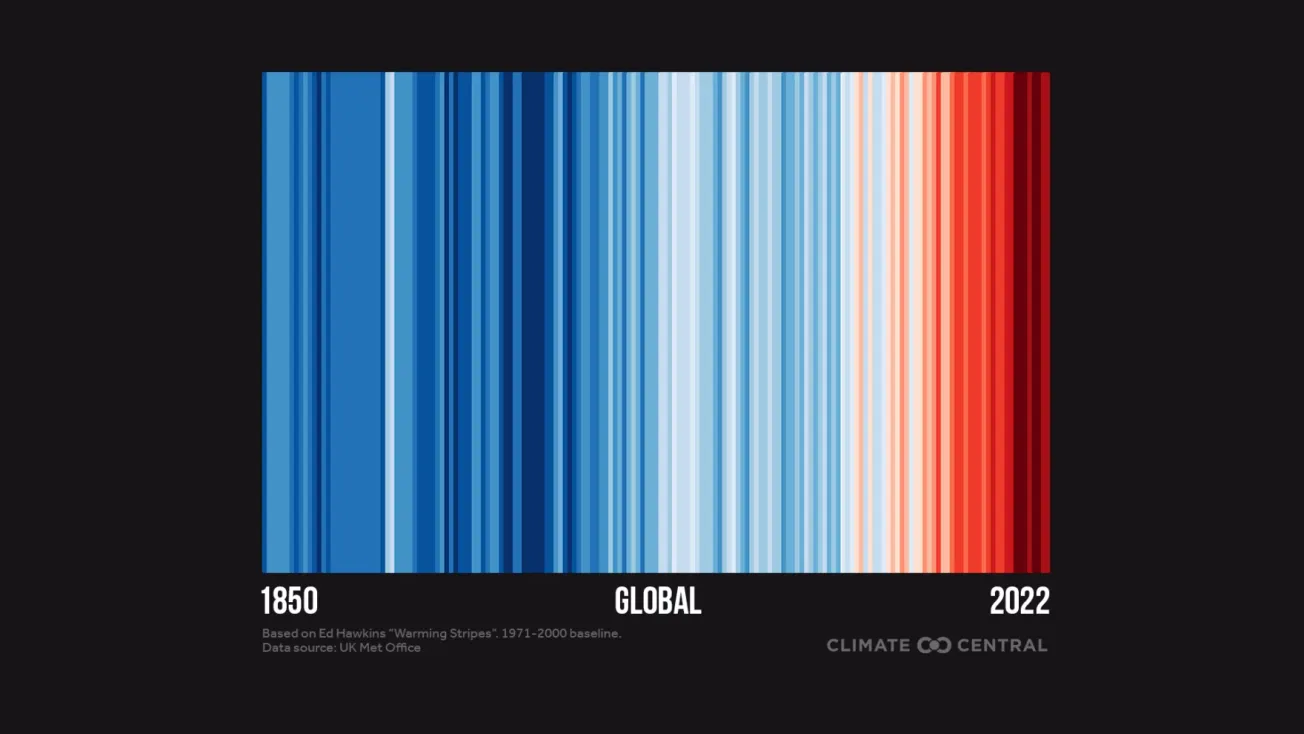Kentucky’s climate is getting warmer and wetter. The burning of fossil fuels is to blame.
The planet’s leading climate scientists warn humankind has not done enough to address climate change. Precious time remains to reduce our reliance on fossil energy.
State officials have no official targets to reduce emissions or to incentivize the use of renewable energy. Kentucky is one of just four states that didn’t apply for up to $3 million to create a climate action plan through the Inflation Reduction Act, according to the Kentucky Lantern.
Many of Kentucky’s elected leaders refuse to even acknowledge the realities of climate change. Others would prefer to use their political capital in pursuit of other interests.
- Republican Attorney General Daniel Cameron recently joined 19 states in opposing the EPA's move to allow California to ban certain gas vehicles by 2035. “This is Democrats’ latest move to surrender America to a woke climate agenda,” he said in a press release.
- In March, President Joe Biden vetoed legislation sponsored by Republican U.S. Congressman Andy Barr, who represents Kentucky's 6th district, that would have overturned Labor Department rules allowing fiduciaries to consider environmental, social, and governance goals when choosing retirement investments.
- U.S. Senate minority leader Mitch McConnell wrote an op-ed in June blasting Biden’s efforts to reduce carbon emissions as a threat to national security.
- State lawmakers passed a new law this year making it more difficult to retire coal-fired power plants.
Kentucky’s winter nights are warmer, the last decade has been wetter, and scientists say natural disasters like last July’s floods in eastern Kentucky will become more frequent.
Rising temperatures are a Rube Goldberg machine of cascading impacts. Every degree of warming will bring its own challenges, both known and unknown, with possible tipping points, die offs and feedback loops. Without action, Kentuckians and the rest of our civilization faces growing risks of poverty, food insecurity, mass migration and the rise of global armed conflict.
Professor Ed Hawkins created the warming stripes infographic in 2018 using a series of vertical blue and red bars. Each bar represents the average temperature for a single year, and when stacked side by side, it’s easy to see how temperatures are rising over time.
It’s a look at the myriad ways climate change has affected, and will affect Kentucky in the decades to come.
How we got here
From plastics to fertilizer to fabrics to energy; fossil fuels define our civilization. But the exponential growth it’s afforded humankind comes at a price.
The planet’s warmed about 1.8 degrees Fahrenheit since the rise of the industrial era. The majority of that warming is the direct consequence of the greenhouse gases we’ve released into the atmosphere through fossil fuel combustion.
Greenhouse gases like carbon dioxide and methane trap heat in the atmosphere. Human activities have increased the amount of carbon dioxide in the atmosphere by 50% in the last two centuries. There’s now more carbon in the atmosphere than at any time in the last four million years.

NOAA/NOAACarbon dioxide levels reconstructed from ice cores, according to the National Oceanic and Atmospheric Administration.
Coal helped to build this country and remains an important part of Kentucky’s heritage but it is also the dirtiest fossil fuel. It’s estimated to be the single largest source of global temperature increase since pre-industrial times, according to the International Energy Agency.
Since the dawn of the state’s mining industry, Kentuckians have mined enough coal to load a train wrapping three-quarters of the way around the planet -- around 10 billion tons’ worth.
Today, Kentucky remains the seventh largest coal producer in the country. Around 71% of the state’s electricity still comes from coal, according to the U.S. Energy Information Administration.
Historical changes in precipitation and temperature
The Fourth National Climate Assessment offers one of the most in-depth analyses of how climate change impacts Kentucky. The report, prepared by the National Oceanic and Atmospheric Administration, lumps Kentucky into the southeastern U.S.
The Southeast has seen less overall warming in daytime maximum temperatures than most of the planet. Researchers hypothesize there are both natural and human reasons why.
Like the rest of the Southeast, Kentucky’s climate records demonstrate cyclical periods of warming and cooling dating back to the late 19th century. The 1930’s were particularly warm while the 60’s and 70’s were particularly cool. However, the Southeast has on average warmed at the same rate as the rest of the country since the ‘60s.
“And then since roughly the 1980s, we've seen rapid warming, such that now this decade is on par with the 1930s,” state climatologist Jerry Brotzge told LPM news.
Five of the 10 warmest years on record in Kentucky have occurred since 2007.

Much of that warming shows up in the record at night. Across the Southeast, the number of nights with minimum temperatures above 75 degrees during the 2010s was nearly double the long term average, according to the national climate assessment.
Over the next three decades, parts of Kentucky will likely experience days when the heat index reaches 125 degrees or higher. A study from the climate nonprofit research group First Street Foundation found Kentucky is likely to join an “extreme heat belt” concentrated in the middle of the country.
Kentucky is also about 10% wetter than it used to be, Brotzge said. That’s attributable to a warmer atmosphere, because a warmer atmosphere holds more moisture. It comes as no surprise then that five of the 10 wettest years on record have occurred in the last decade.
“What we're seeing, especially in the last decade, are fewer drought events but possibly more flooding events,” he said. “You can assume with a warming climate able to hold more water you would expect a wetter climate and in some sense that is what we're seeing.”
Heat
The research nonprofit Climate Central found average summer temperatures in Louisville have warmed 3.4 degrees since 1970.
That extra heat is absorbed by the concrete and asphalt that make up our city centers causing urban heat islands. In 2014, researchers found Louisville had among the worst heat islands in the country — around 10 degrees warmer than the surrounding areas.

Heatwaves are lasting longer and are happening more frequently across the Southeast. Nearly two-thirds of major cities in the region are seeing signs of worsening heat waves – more than any other region in the U.S., according to the national climate assessment.
Heatwaves also typically cause more deaths than other natural disasters including floods and hurricanes, according to the National Weather Service. And it’s not just warmer days, it’s the warmer nights that prevent people from finding relief.
More summer days and warmer nights means more ideal temperatures for mosquitoes, ticks and their vector borne diseases. Already, Louisville already has nearly two more weeks with ideal temperatures for mosquitoes each year than it did in the '80s, according to Climate Central.
Pollution
While Kentucky doesn’t face the same increased wildfire risks as the West Coast, toxic smoke from wildfires can travel great distances affecting air quality in the state as much of the eastern half of the U.S. saw recently with the Canadian wildfires.
Longer summers and warmer drier autumns can also increase the odds of ozone exposure, which forms on hot dry days and increases the risk of asthma, inflammation and premature death. Nearly a century of warmer August temperatures is associated with increased human sensitivity to ground-level ozone, according to the climate assessment.
Cities like Louisville have had trouble with ozone for years. But while some evidence points toward increased ozone concentrations with high temperatures, it’s also possible they could be mitigated by other changes, like switching to electric vehicles.

Finally, rising temperatures and higher levels of carbon dioxide are projected to cause allergenic plants like ragweed to grow faster and produce more pollen. Climate Central estimates Louisville’s growing season is 17 days longer as a result of climate change.
Rainfall
Extreme rainfall events have increased in frequency and intensity across the Southeast, according to the National Climate Assessment. Already, the region’s seen an increase in the number of days with three inches of rain. It’s also seen a 16% increase in observed rainfall over a five year period.
Increased precipitation increases the risks of both flash flooding and river flooding.
While it can be difficult for climate scientists to determine the role that climate change plays in a single event like last July’s floods in eastern Kentucky, they can say with certainty that these are the kinds of impacts that will become more common as the planet warms.
Between 2040 and the end of the century, the extra rainfall across the region is forecast to cause Ohio River maximum stream flows to rise as much as 35%, according to the 2017 Ohio River Basin climate report by the U.S. Army Corps of Engineers.
Agriculture
The warming climate also affects Kentucky's agricultural industry.
The National Climate Assessment predicts the Southeast could lose over one-half billion of labor hours due to heat. These losses are compounded in rural areas dependent on agriculture, forestry and tourism. By 2090, the region could see the largest heat-related impacts on productivity in the country.

Fourth National Climate Assessment/Fourth National Climate AssessmentProjected Changes in Plant Hardiness Zones
The region is also trending toward drier summers and wetter fall seasons, reducing productivity during the growing season while making it more difficult to harvest a full crop, according to the assessment. Corn, soybeans, rice and cotton are among the crops also subject to decreasing productivity as temperatures increase.
Higher overnight temperatures like Kentucky has experienced can increase crops’ water use and reduce yields.
Increasing winter temperatures are also changing the types of plants that can grow in different parts of the country. Over the next few decades, Kentucky's climate will become more like Tennessee's. With fewer freezes, more tropical plants like lemons, oranges, papayas and mangoes could survive in new regions.
Forests
The increased variability in weather patterns is also affecting forests. Trees like the sugar maple and the American beech will struggle to adapt as the climate becomes more tropical.
Species like ramps that grow in the southern Appalachians of Kentucky are sensitive to changes in temperature and soil moisture. A combination of overharvesting, changing temperatures and drier soil are now threatening the species, according to the climate assessment.
The climate crisis exists alongside a growing biodiversity crisis due to changes in land use, urbanization, pollution, invasive species and resource exploitation. There are more than 300 vulnerable species listed in Kentucky including songbirds, reptiles, crayfish, amphibians, mussels and plants.
These forces are playing out at rates unprecedented in human history. As a result, the U.N. estimates 1 million plant and animal species are at risk of extinction across the planet.
A global perspective
It’s not enough to focus on how climate change impacts one little corner of the globe. The planet and its oceans, atmosphere, and weather are dynamic, interconnected systems that we all depend on.
In May, the National Oceanic and Atmospheric Administration announced that carbon dioxide levels are the highest they’ve ever been, even as an increasing number of countries and corporations pledge to rein them in.
The European Union’s climate monitoring agency has recorded the warmest June on record.
The World Meteorological Organization estimates the next five years will be the warmest on record. There’s a 66% chance at least one of those years will temporarily surpass the 2.7 degrees Fahrenheit of warming that the Paris Climate Agreement is designed to avoid.
And while it might be easy for a landlocked state like Kentucky to overlook, 90% of the planet’s warming is actually occurring in the oceans, according to NASA. 2022 was the warmest year on record until this year.
The oceans are the warmest they’ve been since the 19th century, and 2022 was the warmest on record. This year, sea surface temperatures are even warmer, alarming among scientists.
The Greenland ice sheet is melting faster than researchers expected. A report published in "Nature" in early June found the Arctic could see its first ice-free September as early as the 2030s -- regardless of whether we limit our emissions.
The worst impacts of climate change will disproportionately burden the most impoverished parts of the world, sending developing countries and island states to new extremes in flooding, temperatures and food scarcity.
A study from May published in “Nature” found climate change has already pushed more than 600 million people outside the habitable niche that best supports life. Toward the end of the century, that niche may shrink until 3 to 6 billion people are living in regions facing extreme heat, food scarcity and higher risk or mortality.
The basics of climate science have been understood for two centuries. The evidence is unequivocal: burning fossil fuels is the root cause of the changing climate, and until we phase them out, we are generating doom that will hang over the planet for generations to come.
The universe is 13.8 billion years old.
The earth is 4.5 billion years old.
Modern humans are 300,000 years old.
The Industrial Revolution began in a blink of a cosmic eye around 250 years ago.
James Hansen delivered his seminal report on the impacts of global warming to senators in 1988. More than half of all the carbon in the atmosphere has been emitted since that year.
There is still time to avoid the worst outcomes.
United Nations Secretary-General António Guterres says now is the moment to fast-track climate efforts in every country, in every industry and on every timeframe.
“Our world needs climate action on all fronts: everything, everywhere, all at once,” he said.
--30--
Written by Ryan Van Velzer. Cross-posted from Louisville Public Media.







